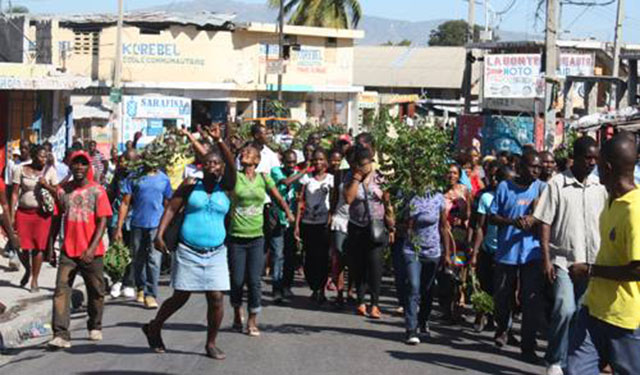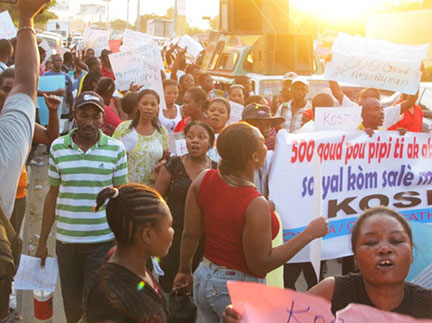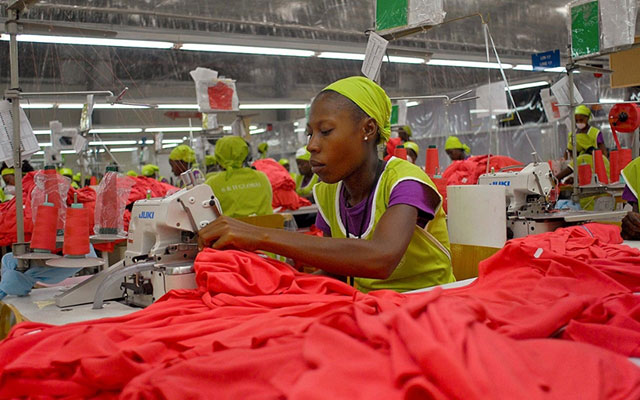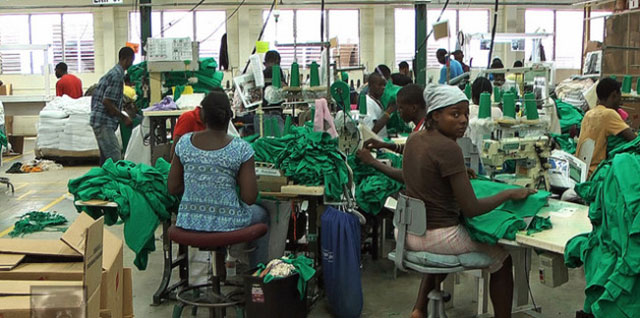
December 2013
Drive Out the MINUSTAH! Workers to Power!
Haiti: Women Workers Strike
Against Starvation Wages
U.S. Unions Must Join the Battle

Predominantly women workers from Port-au-Prince garment export factories march on Haitian parliament demanding raise of the minimum wage, December 10. (Photo: AlterPresse)
This week the anger of workers in Haiti’s export garment industry over their miserable wages finally boiled over. On Tuesday, December 10, hundreds of workers gathered outside the gates of the SONAPI industrial park near the airport outside the capital of Port-au-Prince to demand, as they have for months, a minimum wage of 500 gourdes (US$11.50) per day. As the workers, mostly young women, marched into the city brandishing tree branches hundreds more joined them. Outside the legislature they shouted, “We can’t take it any more,” and “We’re ready to die for 500 gourdes!”
The next day, the scene was repeated. The manufacturer’s association ADIH complained that union activists entered the plants and pulled the workers out, shutting down production. This time they tried to march to the upscale town of Pétionville where Haitian president Michel Martelly lives in the hills above the sweltering capital. However, they were turned back by heavily armed forces of the CIMO riot police. On Thursday, the employers retaliated by locking the workers out “to ensure the safety of employees and their workplace.”
Throughout the last month, workers have been agitating to
raise the minimum wage. On November 7 there was a walkout in
the CODEVI industrial park in Ouanaminthe on the border with
the Dominican Republic. On November 26, the unions took to the
streets of the capital. They complained that under the
existing law, since October 2012 apparel manufacturers were
required pay at least 300 gourdes. The bosses simply refused.
But on November 29, the High Commission on Wages (CSS) decreed
that wages would be “raised” to 225 gourdes, or $5 a day.
 KOSIT garment workers union demonstrates in the
capital for a 500 gourde minimum wage, November 26. (Photo: Batay Ouvriye)
KOSIT garment workers union demonstrates in the
capital for a 500 gourde minimum wage, November 26. (Photo: Batay Ouvriye)Hunger: Everyone admits it is impossible for workers to survive on such starvation wages. In fact, garment workers are constantly in debt and can’t even afford to feed themselves, much less their families. So the government announced the next day that it would subsidize breakfast and lunch at the plants. But that would only be a pittance. A leading Haitian economist, Camille Chalmers, calculated that basic living expenses for a family of four are at least US$25 a day. A 2011 study by the American AFL-CIO labor federation put the bare minimum at US$29 a day.
Radicalization: The head of the Textile and Garment Workers Union (SOTA), Telemarque Pierre, declared: “We know perfectly well that the police are the armed fist of the bosses and the state” (AlterPresse, 12 December). Workers denounced union reps on the CSS who agreed to the $5 a day wage, at least one of them from the U.S.-backed CATH labor federation, as “traitors.” A Collective of Textile Workers Unions (KOSIT) has been formed, including the leftist Batay Ouvriye (Labor Struggle), to organize the walkouts and marches. But it will take much more than that to win this battle.
As in 2009, when thousands of workers repeatedly took to the streets demanding an increase in the minimum wage, workers face bitter opposition not only from the profit-gouging factory owners, but also from Haiti’s bourgeois government and from their imperialist patrons in the U.S. embassy. Against this solid wall of capital, the only road out of grinding poverty for the Haitian masses is an international struggle for socialist revolution, together with Dominican workers and peasants next door and with workers in the U.S. imperialist heartland.
The imperialist media typically present Haiti as a basket case of a county, summed up in photos of malnourished children with distended bellies, for which the only solution is charity, provided by NGOs or Western governments directly. The dire poverty is real, and much of the capital is still in ruins since the January 2010 earthquake, with over 350,000 people still living in makeshift camps. But contrary to the claims of some self-proclaimed leftists who regurgitate the bourgeois images, there is a small Haitian proletariat, concentrated in light industry.1 Roughly 30,000 workers are employed in garment plants producing for export, and though largely non-unionized they have engaged in militant actions when they could.
In 2009, when then-president René Préval got a legislative committee to repeal the 200 gourde minimum wage, thousands of workers walked out of SONAPI to march on parliament. A week later they responded to a police attack by stoning the car of a U.S. diplomat (see “Haiti: Battle Over Starvation Wages and Neocolonial Occupation,” The Internationalist, November 2009). Last fall, when the companies responded to a scheduled increase of the minimum wage to 300 gourdes by raising piece-work quotas, workers at Premium Apparel plant stopped work demanding to talk to the boss. At the nearby One World Apparel factory there was a two-hour wildcat strike. This year thousands demonstrated on May Day demanding 500 gourdes.
Very occasionally the starvation wages of Haitian workers makes it into the “mainstream” media, usually when some respectable NGO or research group makes an issue of it (or in the wake of another murderous factory fire in Bangladesh). Recently, a study by the Worker Rights Consortium (“Stealing From the Poor: Wage Theft in the Haitian Apparel Industry,” 15 October 2013) reported that “the majority of Haitian garment workers are being denied nearly a third of the wages they are legally due as a result of the factories’ theft of their income.” Employers outright refused to pay overtime rates. Instead they essentially imposed a 60-hour workweek (ten hours a day, six days a week).
Earlier this year, a study by Better Work Haiti, a monitoring program set up by the United Nations-affiliated International Labour Organisation and the International Finance Corporation, reported a “100% non-compliance rate in Minimum Wages,” since all 24 garment factories producing for export set piece rates so low that only one out of six workers could make the legal wage of 300 gourdes in eight hours (“Better Work Haiti: Garment Industry 6th Biannual Synthesis Report,” 16 April 2013). The apparel plants were also “100% non-compliant” on medical and safety conditions, with hazardous chemicals unlabeled and none of the legally required medical facilities and staff.
The vast majority of men and women’s underwear sold in the United States is made in Haiti, by contractors working for Hanes Brands, Fruit of the Loom and other retailers. Levi’s jeans, Dickies uniforms and a whole array of garments sold by major chain stores including Gap, Old Navy, Target, Kohl’s, K-Mart and Walmart are produced in these plants. But their labor costs are infinitesimal. Workers at the Genesis factory which makes t-shirts for Montreal-based Gildan Activewear (the largest t-shirt manufacturer in the world) receive one cent (US$.01) for every six shirts their module produces, which would mean producing 3,600 t-shirts just to make the minimum US$7 daily minimum wage. They actually make an average of US$5.55.
 Seamstresses
at work at Caracol industrial park. Average wage: US$4.67 a
day. (Photo: Reuters)
Seamstresses
at work at Caracol industrial park. Average wage: US$4.67 a
day. (Photo: Reuters) The WRC report noted that pay was even lower at the Caracol industrial park inaugurated in October 2012 with great fanfare (and the presence of Bill and Hillary Clinton, movie star Sean Penn, fashion designer Donna Karan and Haiti’s current and former presidents) as the U.S.’ main contribution to Haiti’s post-2010 earthquake reconstruction, although it is 100 miles from the quake zone. The Caracol complex (factory, power plant, housing, and future port) was paid for almost entirely by U.S. AID and Inter-American Development Bank funds. Its only tenant, the Korean SAE-A corporation, vowed to be globally competitive “without compromising on labor and environmental standards. Yet workers there make only US$4.67 a day.
Haitian workers literally cannot live on these starvation wages. Moreover, any conceivable increase in the minimum wage decreed by the government (only to be ignored by the employers) won’t even come close to a living wage. Claims by manufacturers and retailers that this low pay is necessary to remain competitive and that they would go bankrupt if it was significantly raised are hogwash. They could quintupple Haitian garment workers’ wages and only add a few cents to the cost of producing a t-shirt that sells for US$5 to $50 retail. But it is inherent in capitalist exploitation that the bosses will not concede even such a minimal amount unless forced to do so by the action of the workers.
Appeals to the “conscience” of the giant retailing corporations and sweatshop factory owners are useless. The bosses perfectly understand the truth spelled out by Karl Marx in Capital, that their profits derive entirely from the surplus value represented by the difference between what workers are paid for their labor time and what they produce with their labor. Following the publication of the WRC study, Gildan and Fruit of the Loom announced that they would instruct their contractors to pay the minimum wage (Toronto Star, 18 November). But that is peanuts, and Hanes and other retailers refused. Lobbying by liberal groups like United Students Against Sweatshops may win a concession or two, but even that liberal activism has fallen off of late.
What’s required is the mobilization of workers’ power in class struggle, but not just Haitian workers. We’re not dealing with a few fly-by-night contractors. Any serious attempt to raise Haitian garment workers’ pay would likely be met by the “multinational” corporations switching to suppliers in even lower-wage countries, notably Bangladesh and Cambodia. Strikes would be brutally attacked by the “United Nations” occupying force, the MINUSTAH, which acts as mercenaries for U.S. imperialism in suppressing unrest in its Haitian neo-colony. And even legislative action to raise the minimum wage would face massive resistance by the American embassy, which despite Haiti’s small population is the fourth-largest U.S. mission in the world.
A trove of confidential U.S. government cables released in 2011 by the WikiLeaks Internet transparency group revealed a massive embassy operation behind the employer rollback of the 200 gourde ($5) minimum wage law in 2009. A 17 June 2009 cable from U.S. chargé d’affaires Thomas Tighe to his boss Hillary Clinton said that a “200 Haitian gourde minimum wage would make the [assembly] sector economically unviable and consequently force factories to shut down” and “would devastate the industry and negatively impact the benefits of the Haitian Hemispheric through Opportunity Partnership Encouragement Act (HOPE II)” (“WikiLeaks Haiti: Let Them Live on $3 a Day,” The Nation, 1 June 2011).
Going back to the dictatorial regime of Jean-Claude (“Baby Doc”) Duvalier in the 1980s, the U.S.’ “development strategy” for Haiti has always focused on low-wage factory labor. The most immediate effect of this policy was to devastate food production, as hundreds of thousands of impoverished peasants flocked to Port-au-Prince in search of jobs. When the Haitian garment industry was decimated (going from 100,000 jobs to less than 10,000, in good part because of the embargo on Haitian imports backed by liberal Democrats after the Haitian Army’s 1990 ouster of the populist priest-president Jean-Bertrand Aristide), the former workers remained in the capital’s shantytowns which were devastated in the 2010 quake.
Bill Clinton confessed to the U.S. Senate Foreign Relations Committee in 2010 that U.S. policy of gutting Haitian agriculture and forcing massive imports of cheap food staples “may have been good for some of my farmers in Arkansas,” but the consequence was a “loss of capacity to produce a rice crop in Haiti to feed those people because of what I did.” Nevertheless Bill and Hillary are still pushing the policy of starvation-wage factory labor, tourism and agro-industrial export crops in the north. To this has now been added mining, searching for gold in the hills of Quisqueya as the avaricious Spanish conquerors did in the early 1500s (in the course of which they committed genocide against the indigenous Taino population).
Ever since the modern conquistadores of U.S. imperialism first invaded Haiti in 1915, they have pursued economic policies that condemn Haitian workers to endless misery, whether it was producing sugar cane then or t-shirts today. In order to escape from this endless cycle of poverty, it is not enough to pressure the rubber-stamp Haitian parliament or pliant Haitian presidents to pass laws which are never enforced. It is necessary to defeat not only the sweatshop oligarchs like Charles Henry Baker but also their imperialist sponsors. And that requires common class struggle by workers in neo-colonies like Haiti and the Dominican Republic together with their class sisters and brothers in the imperialist heartland.
A real struggle to massively raise wages would have to shut down the entire Haitian export apparel industry. To prevent manufacturers from simply shifting production elsewhere, it would require active support action by U.S. unions, from garment and retail workers to dock workers. Such a campaign requires breaking with the Democrats – the party of Bill and Hillary Clinton, whose policies are a direct cause of Haitian poverty – and a fight to build a class-struggle workers party. In Haiti it means confronting all the bourgeois parties, including the populist Lavalas movement of Aristide, which seeks to silence the struggle to raise the minimum wage. And it requires driving out the MINUSTAH mercenaries who enforce imperialist law-and-order.

Garment workers in Ouanaminthe stitching Hanes t-shirts. (Photo: Jude Stanley Roy/IPS)
In Haiti, the leftist Batay Ouvriye has led protests over the minimum wage, won a union contract at the free trade zone in Ouanaminthe on the Dominican border and is seeking to build unions among garment workers in Port-au-Prince and the Caracol industrial park. B.O. rightly recognizes the “permanent crisis” in Haiti reflects “the historical incapacity to realize a bourgeois national project.” Yet while opposing the grandon landowners, the corrupt granmanjè (big eaters) who feed off the state, the remnants of Duvalier’s macoutes and other bourgeois sectors and recognizing “the imperialists’ objective of exploiting Haitian workers’ sweat and blood,” B.O. does not go beyond simple trade-unionism and talk of a “people’s camp.”
In a lengthy essay analyzing the various bourgeois forces (“The Nature of the Transformation Occurring in Haiti Today,” May 2011), Batay Ouvriye summed up its program by calling for the “popular masses,” “all genuine progressives” and “the people’s side” to be clear that “faced with the failure of the ruling class and all the corrupt politicians, the workers’ interests are the INTERESTS OF THE WHOLE COUNTRY!” This is false and leads ultimately to the same dead-end as the bourgeois populism of Lavalas. In contrast, Leon Trotsky stressed that the working class can become “the leader of the subjugated nation,” standing in the forefront of the struggles of the downtrodden masses against imperialism and its Haitian slave drivers.
To do so, the most conscious sectors must cohere a party of the proletarian vanguard to fight for workers rule on a program of permanent revolution, in which the democratic objectives grow over into socialist measures and the revolution is extended internationally to the imperialist centers. Only on that basis will it be possible to actually put an end to the starvation wages and endemic poverty that have plagued Haiti since it became the first successful slave revolution in history, inspired by the French Revolution of 1789-1894 and in turn inspiring slave revolts from the Caribbean to the United States. Only in this way will it be possible to finally break the colonialist/imperialist blockade that the first black republic of the Americas has faced ever since. ■
- 1. The Spartacist League not only supported the U.S.’ 2010 “humanitarian” invasion of Haiti, a betrayal of basic socialist principle, but even after finally renouncing its shameful “social-imperialist” action (and first lying about it), the SL continued to insist that there is no Haitian working class.
